 |
||||||||
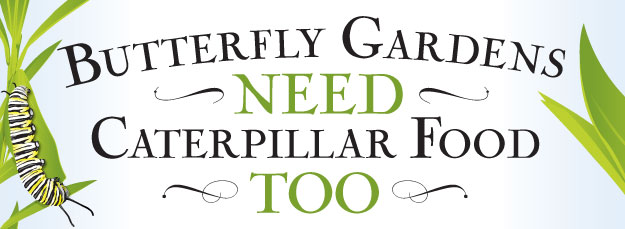 By Victoria Parsons
By Victoria Parsons
Anybody can plant a
butterfly garden with
beautiful blooming flowers
– but people who plant food for caterpillars will have butterfly factories.
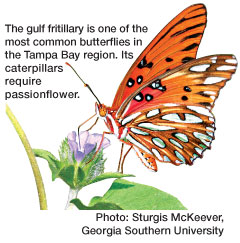 In fact, the most spectacular butterfly garden in the world will be deserted and empty unless there is food for their caterpillars nearby. “Caterpillars are truly specialists,” notes Kristin Gilpin, manager of the BioWorks Butterfly Garden at the Museum of Science and Industry. “Butterflies can nectar on many kinds of flowers, but caterpillars require one or two very specific plants and cannot survive without them.”
In fact, the most spectacular butterfly garden in the world will be deserted and empty unless there is food for their caterpillars nearby. “Caterpillars are truly specialists,” notes Kristin Gilpin, manager of the BioWorks Butterfly Garden at the Museum of Science and Industry. “Butterflies can nectar on many kinds of flowers, but caterpillars require one or two very specific plants and cannot survive without them.”
That challenge has made MOSI’s butterfly exhibit one of the few in the nation where the star performers are born onsite rather than purchased from breeders. With
assistance from a dozen or so dedicated volunteers, Gilpin grows larval food for native caterpillars that are then captured and placed inside a specially cooled area where they are protected from predators as they transform from caterpillars to chrysalises, and finally to the butterflies that flit through the exhibit’s indoor butterfly encounter.
Caterpillars More Challenging
Than Butterflies
Part of the reason that people who plant
butterfly gardens don’t plant caterpillar plants is simply lack of knowledge. “When you stop and think about it, of course butterflies and caterpillars don’t eat the same food, but many of the people visiting the BioWorks gardens just don’t know the difference,” she said.
Another part of the problem is that it’s much harder to find caterpillar food in a “big box” garden store. Caterpillars have been around
for thousands of years, so many of the plants they need may be considered weedy. And even when an attractive larval food like butterfly milkweed is available, it may be treated with pesticides to kill caterpillars because they
chew up leaves and flowers.
 “We plant a lot of the caterpillar food in the back of the garden where the damage is less likely to be noticed but it’s very rare that plants are seriously damaged,” Gilpin said.
“We plant a lot of the caterpillar food in the back of the garden where the damage is less likely to be noticed but it’s very rare that plants are seriously damaged,” Gilpin said.
In some cases, caterpillars have evolved from eating relatively rare native species to more common plants and gardeners may unintentionally destroy
an entire generation
of butterflies by treating plants with
pesticides. Giant swallowtail butterflies,
for instance, require native Hercules club
(seldom planted intentionally because of its ferocious thorns) as larval food but have grown to eat citrus, particularly the new growth that flushes just after the tree has been fertilized. When homeowners see large caterpillars that look more like bird droppings than baby
butterflies damaging their citrus trees, it often prompts them to dowse the tree in pesticides.
The charming “Uncle Sam” or polka-dot moth wasp – which is really a butterfly – is thought to have extended its range when it switched larval food from a practically unknown beach vine to the now-ubiquitous oleander introduced by colonists in the 17th century. Large numbers
of caterpillars with tufts of black hair on bright
orange bodies are not poisonous although they do resemble stinging caterpillars. And while they can transform a healthy oleander into
skeletal remains practically overnight, they are not likely to kill the plant.
A successful butterfly garden is a wonderful thing, but growing plants for caterpillars is even better, Galpin said. “You’ll have many more butterflies because they seldom venture far from their larval food even as adults – and you’ll know that know that your efforts have played an important role in their very existence.”
| Top Four Plants for Caterpillars |
|
|
|
 The larva of a polydamas swallowtail looks quite ferocious but doesn't sting. |
More Resources
The Southwest Florida Water Management District, which sponsors the
BioWorks Butterfly Garden at MOSI, has developed several outstanding
publications on gardening for butterflies and caterpillars. E-mail Gilpin
for a PDF copy at kristeng@mosi.org.
Other Web Resources Include:
Kris Gilpin’s blog that covers all things butterfly, including caterpillars, at http://lepcurious.blogspot.com/
The University of Florida’s extensive documentation on Florida butterflies, including larval food
requirements at http://edis.ifas.ufl.edu/UW057
Florida Atlantic University’s brochure on butterflies and caterpillars has less information but great
photos: http://riverwoods.ces.fau.edu/Education/ButterfliesandCaterpillars.pdf
And every serious caterpillar gardener needs the definitive book on the topic, Florida Butterfly Caterpillars
and Their Host Plants, by UF professors Marc C. Minno, Jerry F. Butler and Donald W. Hall.
Local sources for larval food plants include Kirby’s Nursery in Seffner and Wilcox Nursery in Largo.
For more specific plants, visit Lukas Nursery in Orlando (www.lukasnursery.com) or the Association of
Florida Native Nurseries at www.afnn.org.
Most photos on these pages are courtesy of the Bugwood Network, www.bugwood.org.

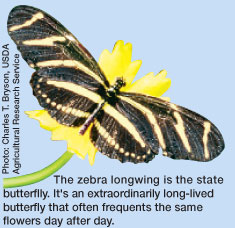 Whether you have a butterfly garden or not, here are Gilpin’s top recommendations for hosting native caterpillars:
Whether you have a butterfly garden or not, here are Gilpin’s top recommendations for hosting native caterpillars: Butterfly gardeners who plant milkweed will have monarchs in their yard nearly year-round because they don’t travel far from their larval food sources. They prefer temperatures between 60 and 80 degrees, though, so populations are likely to be higher in Spring and Fall months.
Butterfly gardeners who plant milkweed will have monarchs in their yard nearly year-round because they don’t travel far from their larval food sources. They prefer temperatures between 60 and 80 degrees, though, so populations are likely to be higher in Spring and Fall months. 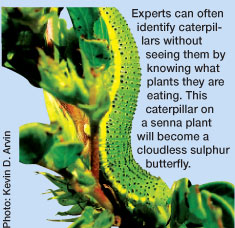
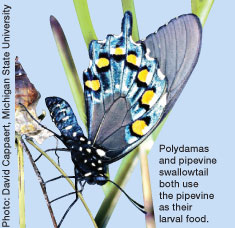 growing well. Be careful where you plant it, though. Passionflower is a native plant but it grows very quickly and can take over a small yard.
growing well. Be careful where you plant it, though. Passionflower is a native plant but it grows very quickly and can take over a small yard.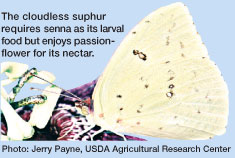 Like milkweed, having a senna plant in your garden also ensures a year-round population of sulphur butterflies but the senna is seldom damaged.
Like milkweed, having a senna plant in your garden also ensures a year-round population of sulphur butterflies but the senna is seldom damaged.